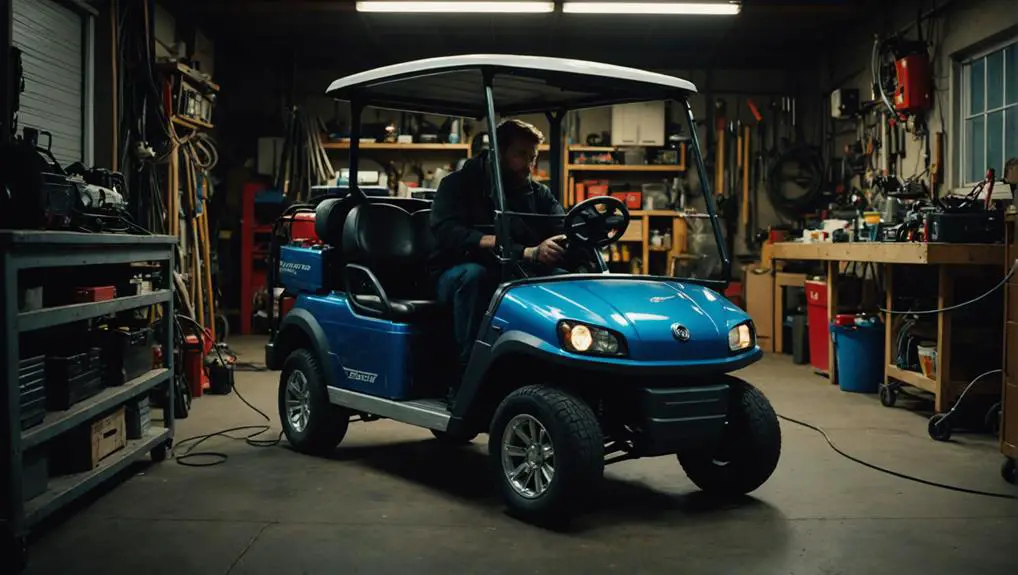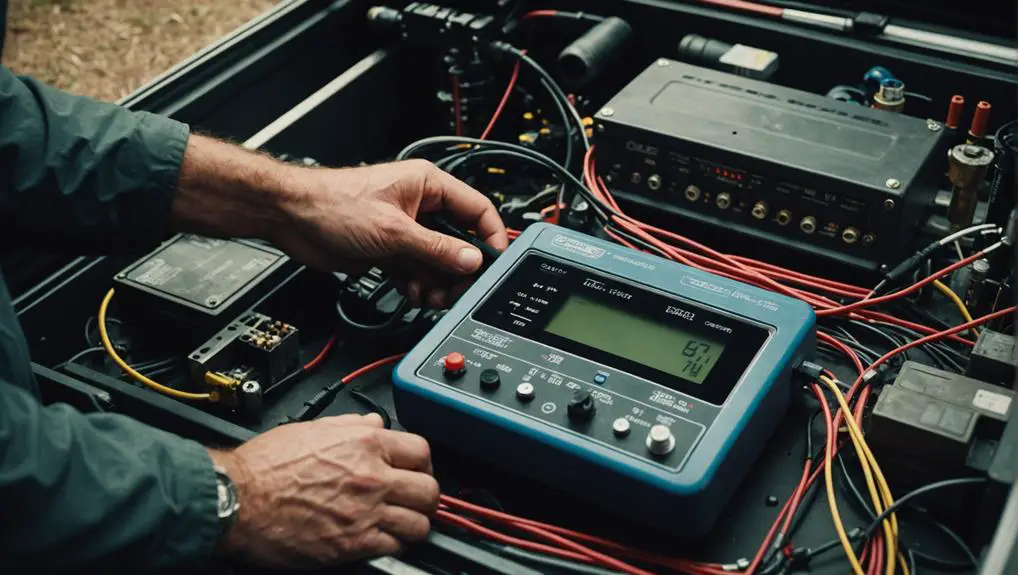You might not realize that even minor issues with your electric golf cart can lead to significant performance problems if left unaddressed. Whether it's a dead battery, slow acceleration, or strange noises, each symptom can point to different underlying causes. Understanding how to systematically troubleshoot these common issues can save you time and frustration. But before you decide to give up on your cart or call for help, let's explore some practical steps you can take to diagnose and fix these problems efficiently.
Key Takeaways
- Check battery voltage with a multimeter; a fully charged battery should read about 12.6 volts for optimal performance.
- Inspect battery terminals for corrosion; clean them with a mixture of baking soda and water if necessary.
- Assess connections, switches, and fuses in the electrical system for looseness or damage to ensure proper functionality.
- Investigate slow acceleration by evaluating battery charge, weight load, and motor condition for any wear or damage.
- Listen for unusual noises; high-pitched squeals or grinding sounds may indicate brake or motor issues that require immediate attention.
Dead Battery Troubleshooting
When dealing with a dead battery in your electric golf cart, the first step is to evaluate the situation systematically. Check the battery's voltage using a multimeter. A fully charged 12-volt battery should read approximately 12.6 volts; anything below 12 volts indicates a depleted battery.
Next, inspect the battery terminals for corrosion or loose connections. Clean any corrosion with a mixture of baking soda and water, and verify the terminals are tight.
If the battery appears dead, consider jump-starting it with a compatible charger or another battery. Follow the manufacturer's instructions to avoid damaging your cart's electrical system. If jump-starting doesn't work, it could indicate a more significant issue, such as a faulty battery or a problem with the charging system.
Additionally, evaluate the age of your battery. Most lead-acid batteries last about four to six years; if yours is older, it might need replacing.
Slow Acceleration Solutions
Have you noticed your electric golf cart struggling to accelerate? This issue can stem from several factors that require your attention.
First, check the battery voltage. A weak or partially charged battery can limit power delivery. Confirm the batteries are charged according to the manufacturer's specifications; if they're old or worn out, consider replacing them.
Next, inspect the connections. Loose or corroded terminals can impede electrical flow, causing sluggish acceleration. Tighten any loose connections and clean corroded terminals to improve performance.
Another aspect to examine is the speed controller. This component regulates the power to the motor. If it's faulty, it can restrict acceleration. Testing the speed controller with a multimeter can help determine if it's functioning correctly.
Don't forget to inspect the motor itself. A worn or damaged motor may not respond as expected. If you notice any unusual wear, consider servicing or replacing the motor.
Lastly, consider the weight load. Excessive weight can affect acceleration; confirm you're within the cart's capacity. By addressing these areas, you should see improved acceleration in your electric golf cart.
Strange Noises Diagnosis

Unusual sounds coming from your electric golf cart can indicate underlying issues that need immediate attention. Recognizing these sounds is vital for timely diagnosis and repair.
For instance, a high-pitched squeal often signals worn brake pads or a failing belt. You should inspect the brake system and the drive belt to determine if they require replacement.
If you hear a grinding noise, it might suggest that the gears in the differential or motor are damaged. To address this, check for any debris, lack of lubrication, or misalignment in the drivetrain components.
A clicking or popping sound can indicate problems with the wheel bearings or axle. It's important to lift the cart and examine these components for wear or damage.
Finally, if you hear a humming noise, it may be related to the electric motor itself. Investigate the motor's brushes and connections, as poor contact can lead to overheating and eventual failure.
In each case, prompt action can prevent more severe damage and guarantee your golf cart remains reliable on the course.
Always consult your user manual or a professional for specific diagnostics and repairs.
Charging System Issues
A reliable charging system is essential for the best performance of your electric golf cart. If you notice that your cart isn't holding a charge, the issue could stem from several factors. First, check the battery connections. Loose or corroded terminals can impede the charging process. Make sure all connections are clean and secure to facilitate peak performance.
Next, inspect your charger. If it's malfunctioning, it may not fully charge the batteries. Test the charger by plugging it into a different cart, if possible. If it works there, your cart's batteries might be the issue. Conversely, if it doesn't work on another cart, replacing the charger may be necessary.
Additionally, consider the age and condition of your batteries. If they're older than five years or show signs of wear, they may not retain a charge effectively. You can test individual batteries with a multimeter to check their voltage levels.
Lastly, make sure that you're using the correct charger for your specific battery type. Using the wrong charger can lead to undercharging or overcharging, both of which can damage your batteries.
Addressing these charging system issues promptly will make certain your golf cart operates efficiently.
Electrical System Checks

Three key components of your electric golf cart's electrical system deserve attention during troubleshooting: the wiring, switches, and fuses.
Start by inspecting the wiring harness for any signs of wear, fraying, or corrosion. Damaged wires can cause intermittent power loss or shorts, so replace any faulty sections immediately.
Next, check the switches, including the ignition and forward/reverse switches. Verify they're functioning correctly by testing for continuity using a multimeter. A malfunctioning switch can lead to a complete failure to start or erratic behavior while driving.
Finally, examine the fuses. Locate the fuse box and visually inspect each fuse for damage. You can test them with a multimeter to confirm they aren't blown. If you find a blown fuse, replace it with one of the same amperage.
After addressing these components, reassemble everything and test the cart's operation. If issues persist, further investigation into the battery and controller may be necessary.
Regular checks on these electrical components can prevent future problems and maintain peak performance of your golf cart.
Frequently Asked Questions
What Regular Maintenance Can Prevent Electric Golf Cart Issues?
To prevent electric golf cart issues, focus on regular maintenance tasks.
Keep the battery terminals clean and check connections for corrosion. Ascertain the batteries are fully charged and water levels are adequate.
Inspect tires for proper inflation and wear. Regularly examine the brakes, lights, and wiring for any signs of damage.
Lubricate moving parts and replace worn components promptly. Following these steps will extend your cart's lifespan and enhance its performance.
How Do Weather Conditions Affect Golf Cart Performance?
You mightn't realize it, but the weather can drastically impact your golf cart's performance.
When temperatures drop, battery efficiency dips, and you may notice sluggish speeds. Conversely, extreme heat can lead to overheating, affecting motor function.
Rain or humidity can cause electrical components to short circuit if not properly protected. By being aware of these conditions, you can adjust your usage and maintenance to keep your golf cart running smoothly, regardless of the weather.
Can I Use My Golf Cart for Off-Road Driving?
You can use your golf cart for off-road driving, but it depends on the cart's design and capabilities.
Standard golf carts aren't built for rough terrain, so they might struggle on uneven surfaces.
If your cart features stronger tires, higher ground clearance, and a robust suspension system, it's better suited for off-road conditions.
Always check the manufacturer's specifications and consider modifications if you plan to take it off the beaten path.
What Are the Signs of an Aging Golf Cart Battery?
If your golf cart battery's performance is fading faster than a superhero in a comic book, it's time to pay attention.
Signs of aging include a reduced range, difficulty holding a charge, and an increase in charging times.
You might also notice corrosion on terminals or a swollen battery case.
Regularly checking water levels and voltage can help you assess its condition, ensuring you enjoy your rides without unexpected breakdowns.
How Often Should I Replace My Golf Cart Tires?
You should replace your golf cart tires every three to five years, depending on usage and wear.
Regularly check for signs of uneven tread wear, cracks, or bulges, as these indicate it's time for a change.
If you frequently drive on rough terrain or in adverse weather conditions, you might need to replace them sooner.
Keeping your tires in good condition enhances safety and improves overall performance, so don't neglect this maintenance.
Conclusion
In the world of electric golf carts, your battery's health is the heartbeat, and addressing issues promptly is like tuning the engine of a finely crafted machine. By routinely checking connections, inspecting the charging system, and listening for unusual sounds, you can guarantee a smooth ride. Remember, just as a gardener tends to their plants, your diligence in maintenance cultivates performance and longevity. Stay proactive, and your electric cart will continue to thrive on the course.